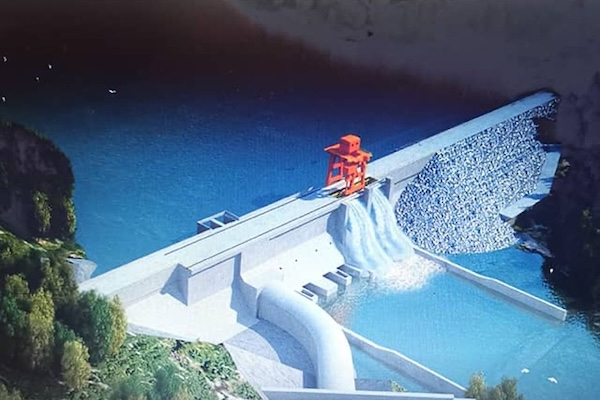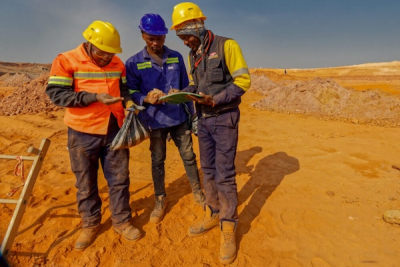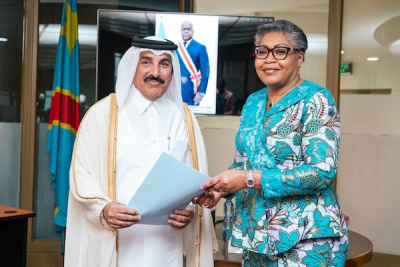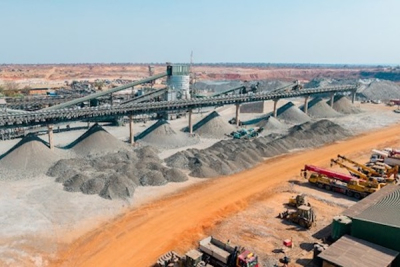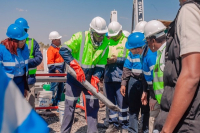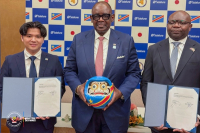
MINING (165)
-
Qatar Investment Authority to acquire 4% stake in Ivanhoe Mines.
-
Deal worth $500 mln awaits Toronto Stock Exchange approval.
-
Funds to support copper, zinc projects in DRC and global exploration.
Ivanhoe Mines said on Sept. 17 it had struck a deal with Qatar’s sovereign wealth fund for a $500 million investment. The agreement gives the Qatar Investment Authority (QIA) a 4% stake in the Canadian miner through the purchase of 57.5 million shares.
The private placement is pending approval by the Toronto Stock Exchange. Ivanhoe’s top shareholders, CITIC Metal Africa Investments and Zijin Mining Group, retain the right to acquire shares at the same price as QIA to keep their level of participation.
QIA chief Mohammed Saif Al-Sowaidi said the investment reflected confidence in Ivanhoe’s assets and its role in supplying minerals for the energy transition. "This strategic investment reflects QIA's belief not only in Ivanhoe Mines' world-class portfolio of assets, but more importantly in supporting its team to find, develop and sustainably supply the minerals essential to the global energy transition and advanced technology applications," he said.
Ivanhoe claimed it plans to channel the funds into exploration and mining projects. In the Democratic Republic of Congo, the TSX-listed firm owns 39.6% of the Kamoa-Kakula copper mine, the country’s largest copper mine, and 62% of the Kipushi zinc mine. Ivanhoe operates both projects.
PM with Ecofin Agency
-
Chinese company Longjing Environmental Protection invests $399 million in a 140 MW hydroelectric plant in DRC's Haut-Lomami province
-
Zijin Mining applies for a concession to develop the 108 MW Mpiana-Mwanga hydroelectric station to power the world-class Manono lithium project
-
Combined projects will supply mining operations while providing electricity to local communities across multiple provinces
According to several trading platforms, Chinese environmental technology company Longjing Environmental Protection will invest $399 million in a 140 MW hydroelectric power plant in the Democratic Republic of Congo (DRC). The move highlights Beijing's deepening energy infrastructure push across mineral-rich Central Africa.
The project in Haut-Lomami province represents the latest phase of Chinese industrial expansion in the DRC, where parent company Zijin Mining operates extensive mining concessions and is positioning itself to tap one of the world's largest lithium deposits.
Lualaba River Project Powers Mining Expansion
Longjing's subsidiary Zijin Longjing secured 80% control of the hydroelectric project through its Hong Kong arm, which acquired rights-holding company GML. Located on the Lualaba River, approximately 200 kilometers from Kolwezi—home to several Zijin Mining concessions—the facility will generate an estimated 714 million kilowatt-hours annually.
Construction is scheduled to take three and a half years, with 90% of electricity earmarked for Zijin's mining sites and 10% allocated to local communities. The project aligns with Longjing's strategy of combining environmental protection with renewable energy development while supporting broader group expansion.
Lithium Ambitions Drive Second Major Project
Simultaneously, Zijin Mining has applied for concession rights to develop the 108 MW Mpiana-Mwanga hydroelectric station on the Luvua River in Tanganyika province. This facility, located over 90 kilometers northeast of Manono, will primarily power the massive Manono lithium project—considered among the world's largest high-grade lithium deposits.
The application, submitted through the Katamba Mining joint venture with Congolese state company Cominière, signals Zijin's commitment to securing reliable power for lithium extraction operations critical to global battery supply chains.
Vice President James Wang indicated the Mpiana-Mwanga station will also serve local communities, including Manono town and territory, Kanuka village, Malemba Nkulu territory, and Manono airfield—demonstrating efforts to balance industrial needs with community development.
Strategic Energy Infrastructure Play
The dual hydroelectric investments reflect a broader Chinese strategy in the DRC: securing energy infrastructure to support mineral extraction while positioning for long-term industrial presence. Zijin Mining's 29.25% stake in Longjing's parent company, Fujian Longking, underscores the integrated approach linking mining operations with power generation.
For the DRC, these projects promise much needed electricity infrastructure while raising questions about resource control and community benefits as Chinese industrial presence expands across the country's mineral-rich provinces.
Timothée Manoke
-
Worker crisis escalates with delayed salaries, reduced benefits, as months-long Chemaf sale uncertainty affects production
-
Bidding competition between an American consortium and a blocked Chinese deal over debt-laden mining assets worth $900M
-
Union pressure mounts for government intervention, written job guarantees, and a dialogue framework amid financial collapse
In the Democratic Congo Republic (DRC), Workers at financially troubled mining company Chemaf Resources are urging Congolese authorities to accelerate a stalled sale process, warning that mounting uncertainty threatens jobs and social stability across the company's operations.
In a memorandum to the Ministry of Employment obtained by the Congolese Press Agency, the Chemaf union delegation highlighted deteriorating conditions as the sale drags on: delayed salary payments, reduced social benefits, and plummeting production levels at facilities including the flagship Mutoshi mine in Kolwezi.
Employee representatives, who say they have been kept in the dark for months about sale negotiations, expressed fears that aging equipment and declining activity could worsen their plight. The union is demanding direct government intervention to remove administrative obstacles, written guarantees for job protection and social rights, and the establishment of permanent dialogue between authorities, management, and workers.
The company's financial crisis has attracted international attention, with Bloomberg reporting that an American consortium including former Special Forces members is currently negotiating to acquire Chemaf's assets. The group comprises Orion Resource Partners and Virtus Minerals, backed by Trafigura, Chemaf's primary creditor.
The potential deal follows a collapsed agreement from June 2024, when Chemaf had arranged to sell its assets—including a major cobalt development project on a Gécamines permit—to Chinese group Norin Mining. However, the state-owned mining company blocked that transaction with a counteroffer, leaving workers in limbo.
Under the proposed American deal, Orion would provide financing while Virtus assumes operational management of a company struggling with debts estimated at nearly $900 million.
The standoff illustrates broader challenges facing Congo's mining sector, where geopolitical competition over critical minerals intersects with urgent needs for economic stability and worker protection.
Ronsard Luabeya
Highlights
• DR Congo and Al Mansour Holding Seal 18 agreements totaling $21 billion.
• These investments are part of a $300 billion fund Doha has dedicated to Africa and Asia, handled via Al Mansour Holding.
On 2nd September 2025, Sheikh Al-Mansour Bin Jabor Bin Jassim Al Thani, leader of Al Mansour Holding and cousin of Qatar’s Emir, arrived in Kinshasa. This visit culminated in the signing of 18 agreements with the Democratic Republic of Congo (DR Congo), totaling $21 billion according to the Prime Minister's office.
The signing ceremony was presided over by Deputy Prime Minster and Transportation Minister Jean-Pierre Bemba and attended by Public Health Minister Roger Kamba, Professional Training Minister Marc Ekila and other government members.
The agreements cover 15 sectors: fishing and livestock, agriculture, environment, public health, telecommunications, occupational training, national identity systems, logistics and transportation, water resources and electricity, finance and banking, cybersecurity, security and defense, urban development, mining and refining (copper, cobalt, gold), and hydrocarbons.
Although Sheikh Al-Mansour is acting as a private investor, these partnerships also involve the State of Qatar. As Jeune Afrique reported in August 2025, the $21 billion designated for DR Congo comes from a $300 billion fund that Doha has set aside for Africa and Asia, managed via Al Mansour Holding.
Key projects include the redevelopment of Kinshasa; the construction of Gateway City in Kasumbalesa; the creation of Congo Pharma, a medical equipment and drug manufacturing facility to reduce imports; the construction of 1.5 million affordable houses; the development of industrial units for the treatment and refining of minerals; and the modernisation of airports, including N'Dolo in Kinshasa.
In the oil and gas sector, there are plans to identify and assign strategic plots to Sonahydroc in the Albertine Graben and Central Basin, before a operational partnership with Amoc Oil and Gas, a subsidiary of Al Mansour Holding, is implemented. To secure these investments, preparatory documents also anticipate the deployment of private security companies in sensitive areas, approved by the Congolese Ministry of Defense.
According to Nidal Ammache, adviser to Sheikh Al-Mansour, these 18 memorandums are the result of a year of collaboration. Upon receiving the letter of intent, Prime Minister Judith Suminwa Tuluka praised a "win-win partnership" that demonstrates her government's openness to private investments, seen as a lever for economic diversification, job creation, and sustainable development.
Before Kinshasa, the Sheikh Al-Mansour and the Qatari delegation he led were in Zambia, Zimbabwe, Mozambique, and Botswana. In these countries, they also sealed deals totaling $51 billion.
The tour is set to continue in Tanzania, Gabon, Burundi, Central African Republic, and Angola, with a total portfolio exceeding $100 billion. With its $21 billion, DR Congo is one of the main recipients of these announced investments.
Timothée Manoke, stagiaire
Highlights
• Kipushi zinc mine boosts concentrator capacity by 20% after upgrades.
• Record output in first week points to global top-5 ranking potential.
• Ivanhoe stays cautious, keeping 2025 forecast unchanged at 180,000–240,000 tonnes.
The Kipushi zinc mine in the Democratic Republic of Congo (DRC), operated by Ivanhoe Mines (62%) and state miner Gécamines (38%), has lifted production following the completion of upgrades to its concentrator and density separator (DMS).
The debottlenecking work, designed to resolve operational setbacks encountered in 2024, increased concentrator capacity by 20%, the company said in a statement released on August 27, 2025.
Within a week of restarting operations, Kipushi delivered 5,545 tonnes of zinc in concentrate — a record output equivalent to an annualized rate of 290,000 tonnes. At that pace, the mine could rank as the world’s fourth-largest zinc producer, according to a June 2024 GlobalData survey published by Mining Technology.
Despite the strong start, Ivanhoe has kept its 2025 production forecast at 180,000–240,000 tonnes.
The upgrade follows a challenging 2024, when high iron content in ore from the top of the deposit reduced recovery rates and forced Ivanhoe to lower its forecast from 100,000–140,000 tonnes to 50,000–70,000 tonnes. Actual output was 50,307 tonnes.
To address the issue, Ivanhoe launched a concentrator and DMS upgrade program in September 2024. According to early results, 42,736 tonnes of concentrate were produced in Q1 2025. The company now states that the work has been completed ahead of schedule and under budget, although it had previously informed investors that it expected to spend $25 million this year at Kipushi.
On the sales side, Ivanhoe signed an offtake deal in July with Swiss trader Mercuria for one-third of Kipushi’s output not already committed to CITIC Metal (HK) and Trafigura Asia Trading. Mercuria will also provide a $20 million loan at 6% interest.
Timothée Manoke, intern
-
U.S. firms push for DRC-Rwanda critical minerals agreement to foster economic growth and stability.
-
Roundtable discussions focused on investments and security, part of a regional integration framework.
-
The initiative aims to counter Chinese influence and increase U.S. private sector engagement in the region.
American business leaders are pressing for closer cooperation between the Democratic Republic of Congo (DRC) and Rwanda on critical minerals, seeking to turn the region’s vast resources into engines of growth rather than sources of conflict.
Securing America’s Future Energy (SAFE), a U.S. nonprofit that includes Fortune 500 executives on its board, hosted a roundtable in Washington on Aug. 28 with delegations from both countries. Talks focused on investment opportunities in critical minerals and regional security, SAFE said.
The meeting builds on a peace deal signed in June between Kinshasa and Kigali, which paved the way for a Regional Economic Integration Framework aimed at boosting trade and investment in supply chains for cobalt, lithium, and other minerals. A preliminary agreement was signed on Aug. 1, with a full deal expected by Sept. 27.
SAFE, which works closely with the U.S. State Department, said the framework could increase American private-sector investment while reducing reliance on conflict minerals and limiting China’s dominance in the sector.
At the same time, Kinshasa and Washington are negotiating a bilateral pact on strategic minerals. Several U.S. companies are already active in the DRC, including KoBold Metals in exploration and Starlink in satellite internet. Other Fortune 500 firms are also weighing entry into Congo’s resource sector.
This article was initially published in French by Boaz Kabeya
Adapted in English by Ange Jason Quenum
KoBold Metals, a U.S. company backed by Bill Gates and Jeff Bezos, has been granted seven new mining exploration permits in the Democratic Republic of Congo (DRC), international news reports said on August 27, 2025. According to data from the Mining Cadastre (CAMI), four of the permits are located in the Manono territory of Tanganyika province, with three others in Malemba Nkulu in Haut-Lomami province.
The move follows a preliminary agreement signed in July that allows KoBold to launch a large-scale exploration program across a 1,600 km² area. In accordance with the Congolese mining code, the exploration permits are valid for five years and grant KoBold the exclusive right to carry out work on the designated minerals, with work required to begin within one year.
The permits cover a dozen minerals, including lithium, coltan, and rare earths. However, an unnamed company official told Reuters that exploration efforts will focus on lithium. A portion of the Manono site is considered to hold one of the world's largest lithium deposits, though it remains at the center of a legal dispute.
The Australian company AVZ Minerals claims the Congolese government illegally terminated its rights to a permit covering a section of the site, which it initially held in partnership with the state-owned company Cominière. AVZ has initiated international arbitration at the International Centre for Settlement of Investment Disputes (ICSID). The process was frozen for a time in anticipation of an amicable settlement but resumed in June.
Under the preliminary agreement signed in July, KoBold is responsible for resolving the dispute. In that effort, KoBold and AVZ announced a framework agreement on May 6 for AVZ to sell its business interests in the Manono deposit at a "fair value." AVZ confirmed on July 21 that discussions remain ongoing.
Meanwhile, another part of the deposit is already under the control of China's Zijin Mining Group, which holds an exploitation permit for the northeast zone. According to its 2024 annual report, preliminary surveys identified 2.62 million tons of lithium oxide at an average grade of 1.5%, which is equivalent to approximately 6.47 million tons of lithium carbonate. Zijin plans to begin production in the first quarter of 2026.
The granting of permits to KoBold is part of a strategic alignment between Kinshasa and Washington. The Congolese and U.S. governments have engaged in discussions to link mining concessions with security support, as Washington seeks to reduce its industries' dependence on China's dominance of strategic mineral supply chains. Lithium, which is essential for manufacturing electric vehicle batteries, is central to these efforts.
Timothée Manoke (Intern)
Cadastre minier (CAMI), the state body managing mining rights in the Democratic Republic of Congo (DRC), has reminded holders of mining rights of their regulatory obligations to begin work. In a statement dated August 20, 2025, and signed by its director general, Popol Mabolia Yenga, CAMI issued a warning that failure to comply could result in the revocation of titles.
The document includes a list of 93 titles at risk of cancellation for non-compliance with legal provisions. Of these, 55 are exploration permits and 33 are exploitation licenses. The list features prominent companies, including Tenke Fungurume Mining, cited for two titles covering six mining blocks in Lualaba province, and Cimenterie de Lukala (Cilu), which holds a title for five mining blocks in the Kongo Central province.
CAMI is enforcing articles 387 and 391 of the Mining Regulations, which require holders of mining and quarrying rights to provide proof that work has commenced within prescribed deadlines: one year from the date of issuance for exploration permits, and between one and three years for exploitation licenses, depending on the case.
Failure to comply exposes operators to the forfeiture of their rights, followed by definitive cancellation after an investigation. The Mining Code also stipulates that any holder whose rights have been forfeited is barred from obtaining new mining or quarrying rights for a period of five years.
This warning comes amid an increasingly strict approach to managing the DRC's mining sector. On August 4, 2025, CAMI submitted its cadastral registry cleanup report to the Minister of Mines, which stated that 594 mining and quarrying titles covering 37,253 mining blocks had been freed up for new investors. The report also noted the regularization of 210 rights that had been under a force majeure status, reclassifying them as active and subject once again to their fiscal, social, and technical obligations.
In 2024, the cleanup process led to the cancellation of over 1,000 non-compliant titles, helping CAMI exceed its budget forecasts for the first quarter of that year by 185.05%.
Timothée Manoke (Intern)
Japanese firm Solafune has signed a definitive agreement with the National Geological Service of Congo (SGNC), the Ministry of Mines announced on August 23, 2025. The deal, signed on the sidelines of the 9th Tokyo International Conference on African Development (TICAD9), was attended by Mines Minister Louis Watum Kabamba.
The document follows a memorandum of understanding reached in July. While details were not disclosed, the ministry said the first phase of the partnership “starts immediately” and introduces a platform combining satellite remote sensing and geospatial technology with artificial intelligence. The aim is to equip Congolese geologists with modern tools to improve knowledge of the national subsoil, about 90% of which remains unexplored.
Minister Watum Kabamba described the technology transfer as “a decisive step” for national technical services, urging the SGNC to fully exploit the tools to expand geological mapping and accelerate the discovery of new deposits.
The agreement comes as mining exploration in DR Congo increasingly turns to advanced technology. U.S.-based KoBold Metals, backed by Jeff Bezos and Bill Gates, is preparing to use satellite data and AI to explore Congolese deposits. The company has applied for a research permit covering 1,600 km² and signed an agreement with the mining cadastre (CAMI) to digitize geological archives preserved at the Royal Museum for Central Africa.
-
Kibali produced 306,667 ounces in H1 2025, below the half-year target of 344,000–377,500 ounces.
-
Production is down 13% year-on-year due to lower ore grades and operational challenges.
-
Strong gold prices boosted revenues despite lower output
The Kibali gold mine in Haut-Uélé province, DRC, produced 306,666.6 ounces (8,693.8 kg) of gold in the first half of 2025. Barrick Mining, the mine’s operator, reported the figure on August 11. This output falls short of the half-year target of 344,000–377,500 ounces and marks a 13% decline compared with 351,111 ounces in the same period of 2024.
AngloGold Ashanti, which holds a 45% stake in the mine alongside Barrick, attributes the decline to lower ore grades. “Operational difficulties have reduced the amount of underground ore available for processing, increasing the use of lower-grade open-pit ore,” the company said. Barrick had previously forecast higher underground grades later in the year, but this has not yet materialized.
Despite the production drop, high gold prices have bolstered revenue. Kibali’s first-half average selling price is forecast at $3,099 per ounce, up from $2,213 a year earlier. The mine generated $702.2 million in sales in 2024, and analysts from Canadian firm Fidelity anticipate gold could reach $4,000 per ounce by year-end, supporting Barrick’s revenue growth even amid lower output.
This article was initially reported in French by Pierre Mukoko
Adapted in English by Ola Schad Akinocho
More...
• The DRC and Rwanda initialed a new regional economic integration framework on August 1, as part of the June 27 peace agreement.
• The framework aims to formalize mineral supply chains, curb illicit trade, and improve local benefits from resource exploitation.
• U.S. investors are closely watching the process, with strategic minerals and transparency topping the agenda.
By initialing the "text of principles" for a regional economic integration framework in Washington on August 1, 2025, the Democratic Republic of Congo (DRC) and Rwanda have taken a tentative but meaningful step toward regulating their shared mineral trade. The document, still confidential, is a follow-up to the peace agreement signed between the two countries on June 27 and is expected to pave the way for greater transparency and regional cooperation.
The framework is described as building upon existing African integration efforts, including the African Continental Free Trade Area (ZLECAf), the International Conference on the Great Lakes Region (CIRGL), the Economic Community of the Great Lakes Countries (CEPGL), and the East African Community (EAC).
According to the peace agreement, the two countries are expected to leverage the framework to "develop foreign trade and investment from the region’s supply chains of critical minerals and introduce greater transparency." The underlying goal is to dismantle illicit circuits that have long fueled regional instability and to promote inclusive prosperity through formalized and regulated resource flows.
This move could mark a turning point in the informal mining trade between the DRC and Rwanda, which has been the subject of multiple UN reports alleging illegal trafficking of minerals — including gold, coltan, and tantalum — mined in eastern DRC and re-exported via Rwanda under new labeling.
American interests in the firing line
For Kinshasa, the formalization process represents an opportunity to recapture lost revenues and align its resource exports with international standards. This is particularly relevant for minerals extracted in conflict-affected regions, which often face scrutiny under global sourcing regulations.
The United States, for its part, has expressed support for the initiative and is engaged in parallel talks with the DRC for a dedicated agreement on strategic minerals. U.S. companies such as Kobold Metals and Starlink are already present in the country, and the Biden administration sees regulated supply chains as critical to both commercial and geopolitical interests.
According to sources close to the talks, a more detailed final agreement is expected by September 27. The rollout of the new regional framework is to begin within three months of the peace agreement’s entry into force, although implementation is likely to be phased.
Whether the text of principles leads to concrete, enforceable changes will depend on political will, investor confidence, and the ability of both countries to implement cross-border oversight mechanisms without reigniting old tensions.
This article was initially reported in French by Pierre Mukoko
Edited in English by Ola Schad Akinocho
Twenty-nine new oil blocks cover 72% of the Kivu-Kinshasa Green Corridor, a protected ecological zone.
The Green Corridor spans 544,270 km², aiming to protect over 100,000 km² of primary forest and promote a green economy.
Environmentalists warn oil exploration threatens the project’s climate goals and international reputation.
The Democratic Republic of Congo (DRC) balances two conflicting ambitions: becoming a major oil producer while solidifying its role as a climate change solution country. A June 20, 2025 map analysis by NGO Earth Insight reveals 29 newly auctioned oil blocks overlap 72% of the Kivu-Kinshasa Green Corridor.
Created on January 15, 2025, the Green Corridor aims to position the DRC as a global leader in combating climate change. The corridor covers 544,270 km²—over a quarter of the nation—and protects more than 100,000 km² of primary forests. Its founding decree mandates that any new economic projects within the corridor align with this green vision. However, oil extraction directly contradicts this goal.
In December 2024, Deputy Prime Minister and Environment Minister Ève Bazaibatold Deutsche Welle that mining permits granted inside the Green Corridor would be revoked. Since 2018, the state oil company Comico holds three blocks in Équateur province, including Busira and Mbandaka, which lie inside the corridor boundaries defined in 2025.
Hydrocarbons Minister Aimé Sakombi Molendo responded to criticism in Jeune Afrique by stating that the auctioned blocks had been “detoxified” to exclude protected zones. The government maintains it will not back down, aiming to balance exploration and production with safeguarding future generations’ interests.
Earth Insight strongly challenges this approach. The NGO argues that auctioning fossil fuel concessions within the Green Corridor undermines its international credibility and breaches commitments to biodiversity and climate action. The stakes are high given the corridor’s dependence on outside funding.
President Félix Tshisekedi estimates the project needs one billion dollars over three to four years to succeed. In January 2025 at the World Economic Forum in Davos, he showcased the Green Corridor and secured pledges from the European Union and Team Europe initiative to mobilize one billion euros in support for the community-based protected area.
Timothée Manoke, intern
Highlights:
• 60 MW solar project underway; target expansion to 120 MW with no timeline yet
• Two PPAs signed with CrossBoundary (Kenya) and Green World (China), each for 30 MW
• Kamoa-Kakula mine to rely solely on green energy by 2026; demand projected at 240 MW
Kamoa Copper plans to gradually scale up solar power capacity at its Kamoa-Kakula copper complex in the Democratic Republic of Congo (DRC), aiming for an installed capacity of 120 MW. Ivanhoe Mines, a key shareholder and the operator of the site, disclosed the information in a press release issued July 8, 2025. No specific timeline for the expansion was provided.
Currently, a 60 MW solar power plant with battery storage is under construction at the site near Kolwezi, Lualaba province. This infrastructure stems from two power purchase agreements signed in late March and early April 2025. Each agreement covers 30 MW and involves CrossBoundary Energy DRC, based in Nairobi, and Green World Energie SARL, headquartered in Beijing. Both companies are responsible for financing, building, and operating their respective units.
CrossBoundary confirmed its contract will run for 17 years, while Green World has not disclosed the terms of its agreement.
Initial site work began in Q2 2025, including geotechnical assessments, land clearing, and procurement of long-lead equipment, such as the battery energy storage system (BESS), a modular electrical station (E-house), and structural assemblies. Commissioning is slated for mid-2026.
By that time, electricity demand at Kamoa-Kakula is expected to reach 240 MW. The operator aims to meet this requirement entirely through renewable sources, including an increased supply of hydroelectricity from the national grid. This will be enabled by the ongoing rehabilitation of turbine 5 at the Inga II dam, which is expected to deliver 178 MW once grid reinforcement is complete in 2026.
With the new capacity, Kamoa-Kakula could stop relying on electricity from Zambia and Mozambique. In April, Ivanhoe reported an increase in hydro imports from 50 MW to 70 MW, with a potential ramp-up to 100 MW.
This article was initially published in French by Pierre Mukoko
Edited in English by Ola Schad Akinocho
Highlights:
• DRC signs strategic deals with KoBold Metals and Solafune to modernize geological data systems
• KoBold to digitize archives and launch exploration campaign over 1,600 km² by the end of July
• Solafune to support AI-based mapping and expert training under new MoU
The Democratic Republic of Congo has signed two preliminary agreements with U.S.-based KoBold Metals and Japan's Solafune Inc. to modernize access to geological data and bolster mineral exploration using artificial intelligence and satellite technology.
KoBold, backed by Bill Gates and Jeff Bezos, will digitize Congo’s geological archives held at the Royal Museum of Central Africa by July 31, 2025. The company also plans to launch large-scale mineral exploration, submitting permit applications covering 1,600 km² by the same date. Under the agreement, all data generated will be made publicly accessible through the National Geological Service of Congo (SGN-C), which will also act as the official platform for data validation and archiving.
Solafune, meanwhile, signed a memorandum of understanding to provide AI-driven support for geological mapping and train Congolese experts. The goal is to increase transparency and improve governance of mineral resources through better subsurface knowledge.
Congolese authorities describe the KoBold deal as a "strategic partnership" aimed at attracting U.S. investment. In 2024, the DRC led African mining exploration with $130.7 million in investment—10% of the continent’s total—according to S&P Global Market Intelligence.
This article was initially published in French by Ronsard Luabeya, intern
Edited in English by Ola Schad Akinocho







